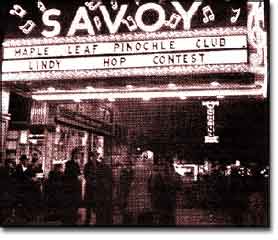46e. The Harlem Renaissance

The Savoy Ballroom in Harlem in 1926 was The Place and Lindy Hop was The Dance!
It was time for a cultural celebration. African Americans had endured centuries of slavery and the struggle for abolition. The end of bondage had not brought the promised land many had envisioned. Instead, white supremacy was quickly, legally, and violently restored to the New South, where ninety percent of African Americans lived. Starting in about 1890, African Americans migrated to the North in great numbers. This Great Migration eventually relocated hundreds of thousands of African Americans from the rural South to the urban North. Many discovered they had shared common experiences in their past histories and their uncertain present circumstances. Instead of wallowing in self-pity, the recently dispossessed ignited an explosion of cultural pride. Indeed, African American culture was reborn in the Harlem Renaissance.
The Great Migration
The Great Migration began because of a "push" and a "pull." Disenfranchisement and Jim Crow laws led many African Americans to hope for a new life up north. Hate groups and hate crimes cast alarm among African American families of the Deep South. The promise of owning land had not materialized. Most blacks toiled as sharecroppers trapped in an endless cycle of debt. In the 1890s, a boll weevil blight damaged the cotton crop throughout the region, increasing the despair. All these factors served to push African Americans to seek better lives. The booming northern economy forged the pull. Industrial jobs were numerous, and factory owners looked near and far for sources of cheap labor.
Unfortunately, northerners did not welcome African Americans with open arms. While the legal systems of the northern states were not as obstructionist toward African American rights, the prejudice among the populace was as acrimonious. White laborers complained that African Americans were flooding the employment market and lowering wages. Most new migrants found themselves segregated by practice in run down urban slums. The largest of these was Harlem. Writers, actors, artists, and musicians glorified African American traditions, and at the same time created new ones.
Writers and Actors
The most prolific writer of the Harlem Renaissance was Langston Hughes. Hughes cast off the influences of white poets and wrote with the rhythmic meter of blues and jazz. Claude McKay urged African Americans to stand up for their rights in his powerful verses. Jean Toomer wrote plays and short stories, as well as poems, to capture the spirit of his times. Book publishers soon took notice and patronized many of these talents. Zora Neale Hurston was noticed quickly with her moving novel, Their Eyes Were Watching God. Music met prose in the form of musical comedy. The 1921 production of Shuffle Along is sometimes credited with initiating the movement. Actor Paul Robeson electrified audiences with his memorable stage performances.
Musicians
No aspect of the Harlem Renaissance shaped America and the entire world as much as jazz. Jazz flouted many musical conventions with its syncopated rhythms and improvised instrumental solos. Thousands of city dwellers flocked night after night to see the same performers. Improvisation meant that no two performances would ever be the same. Harlem's Cotton Club boasted the talents of Duke Ellington. Singers such as Bessie Smith and Billie Holiday popularized blues and jazz vocals. Jelly Roll Morton and Louis Armstrong drew huge audiences as white Americans as well as African Americans caught jazz fever.
The continuing hardships faced by African Americans in the Deep South and the urban North were severe. It took the environment of the new American city to bring in close proximity some of the greatest minds of the day. Harlem brought notice to great works that might otherwise have been lost or never produced. The results were phenomenal. The artists of the Harlem Renaissance undoubtedly transformed African American culture. But the impact on all American culture was equally strong. For the first time, white America could not look away.






